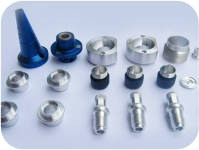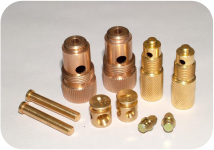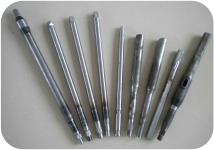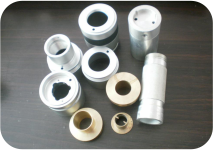Cnc lathe turning service
Why Use CNC Turning For Your Project?
Vowin’ CNC machining service can deliver machined parts, in both plastic and metal, in less time than it takes to get a quote from other, more traditional machine shops. Upload a CAD file, choose the material and part quantity, and tell us when you need the parts. We also offer a number of CNC specific secondary services to support your project.
CNC material data sheets can be found in our Material Comparison Guide
What is CNC Turning?
CNC Turning is a manufacturing process in which bars of material are held in a chuck and rotated while a tool is fed to the piece to remove material to create the desired shape. A turret (shown center), with tooling attached is programmed to move to the bar of raw material and remove material to create the programmed result. This is also called “subtraction machining” since it involves material removal. If the center has both tuning and milling capabilities, such as the one above, the rotation can be stopped to allow for milling out of other shapes.
The starting material, though usual round, can be other shapes such as squares or hexagons.
Depending on the bar feeder, the bar length can vary. This affects how much handling is required for volume jobs.
CNC lathes or turning centers have tooling mounted on a turret which is computer-controlled. The more tools that that the turret can hold, the more options are available for complexities on the part.
CNC’s with “live” tooling options, can stop the bar rotation and add additional features such as drilled holes, slots and milled surfaces.
Some CNC turning centers have one spindle, allowing work to be done all from one side, while other turning centers, such as the one shown above, have two spindles, a main and sub-spindle. A part can bPhotoGallerye partially machined on the main spindle, moved to the sub-spindle and have additional work done to the other side this configuration.
There are many different kinds of CNC turning centers with various types of tooling options, spindle options, outer diameter limitations as well as power and speed capabilities that affect the types of parts that can be economically made on it.
How Does CNC Turning Work?
During the CNC turning process, a metal rod is rotated while a cutting tool is held against the stock to remove material and create final parts. The lathe rapidly machines your parts in a subtractive turning process with additional live tooling. Outside diameter (OD) and inside diameter (ID) threading is also available.
Turned parts can then be left as-machined, with visible tool marks, or bead blasted. When the run is complete, parts are inspected, boxed and shipped shortly thereafter.
Top 5 Benefits To You choice CNC lathes turning service:
Opting for CNC lathes instead of traditional alternatives – or a different, less effective manufacturing component method – enables us to provide our customers with a number of important benefits, including:
Consistency
– We fully understand the need for our components to be consistently produced to a high standard. Due to the complexity of the turning process this is almost impossible in a manual lathe, even when operated by a highly experienced engineer. A CNC lathe eliminates this issue. Parts machined using a CNC lathe are identical, so customers experience the same level of consistency from each and every one of their components.
Accuracy
– Much like consistency, the accuracy of parts produced in a manual lathe can vary considerably. A CNC lathe, however, follows the exact same instructions and cutting path each time to ensure parts are exactly the same.
Turnaround time
– CNC lathes speed up the turning process significantly. While high accuracy is possible on a manual lathe with careful measuring and cutting, the process takes a long time and requires a lot of attention. A CNC lathe makes the process much quicker and easier, cutting highly accurate pieces faster than a manual operator can. This means we can supply customers with their components much sooner than most.
Volume
– Since our CNC lathes allow us to manufacture components quicker, we’re also able to produce greater volumes to satisfy both small and large orders. They can operate 24 hours a day, 365 days per year – so you’ll always have the parts you need, when you want them.
Production costs
– Since the time required for our engineers to be operating our lathes is cut through using CNC, our production costs are much lower than those who continue to operate manually. These cost savings are passed on, so you benefit from a more budget-friendly production process.
We have a wide range of CNC lathes, enabling us to produce almost any component required by customers. Check out our plant list for a full itemisation of the CNC machining equipment we own.
Turning is a engineering machining process in which a cutting tool, typically a non-rotary tool bit, describes a helical toolpath by moving more or less linearly while the workpiece rotates. The tool's axes of movement may be literally a straight line, or they may be along some set of curves or angles, but they are essentially linear (in the nonmathematical sense).
Usually the term "turning" is reserved for the generation of external surfaces by this cutting action, whereas this same essential cutting action when applied to internal surfaces (that is, holes, of one kind or another) is called "boring". Thus the phrase "turning and boring" categorizes the larger family of (essentially similar) processes. The cutting of faces on the workpiece (that is, surfaces perpendicular to its rotating axis), whether with a turning or boring tool, is called "facing", and may be lumped into either category as a subset. Turning can be done manually, in a traditional form of lathe, which frequently requires continuous supervision by the operator, or by using an automated lathe which does not. Today the most common type of such automation is computer numerical control, better known as CNC. (CNC is also commonly used with many other types of machining besides turning.)
When turning, a piece of relatively rigid material (such as wood, metal, plastic, or stone) is rotated and a cutting tool is traversed along 1, 2, or 3 axes of motion to produce precise diameters and depths. Turning can be either on the outside of the cylinder or on the inside (also known as boring) to produce tubular components to various geometries. Although now quite rare, early lathes could even be used to produce complex geometric figures, even the platonic solids; although since the advent of CNC it has become unusual to use non-computerized toolpath control for this purpose.
The turning processes are typically carried out on a lathe, considered to be the oldest machine tools, and can be of four different types such as straight turning, taper turning, profiling or external grooving. Those types of turning processes can produce various shapes of materials such as straight, conical, curved, or grooved workpiece. In general, turning uses simple single-point cutting tools. Each group of workpiece materials has an optimum set of tools angles which have been developed through the years.











